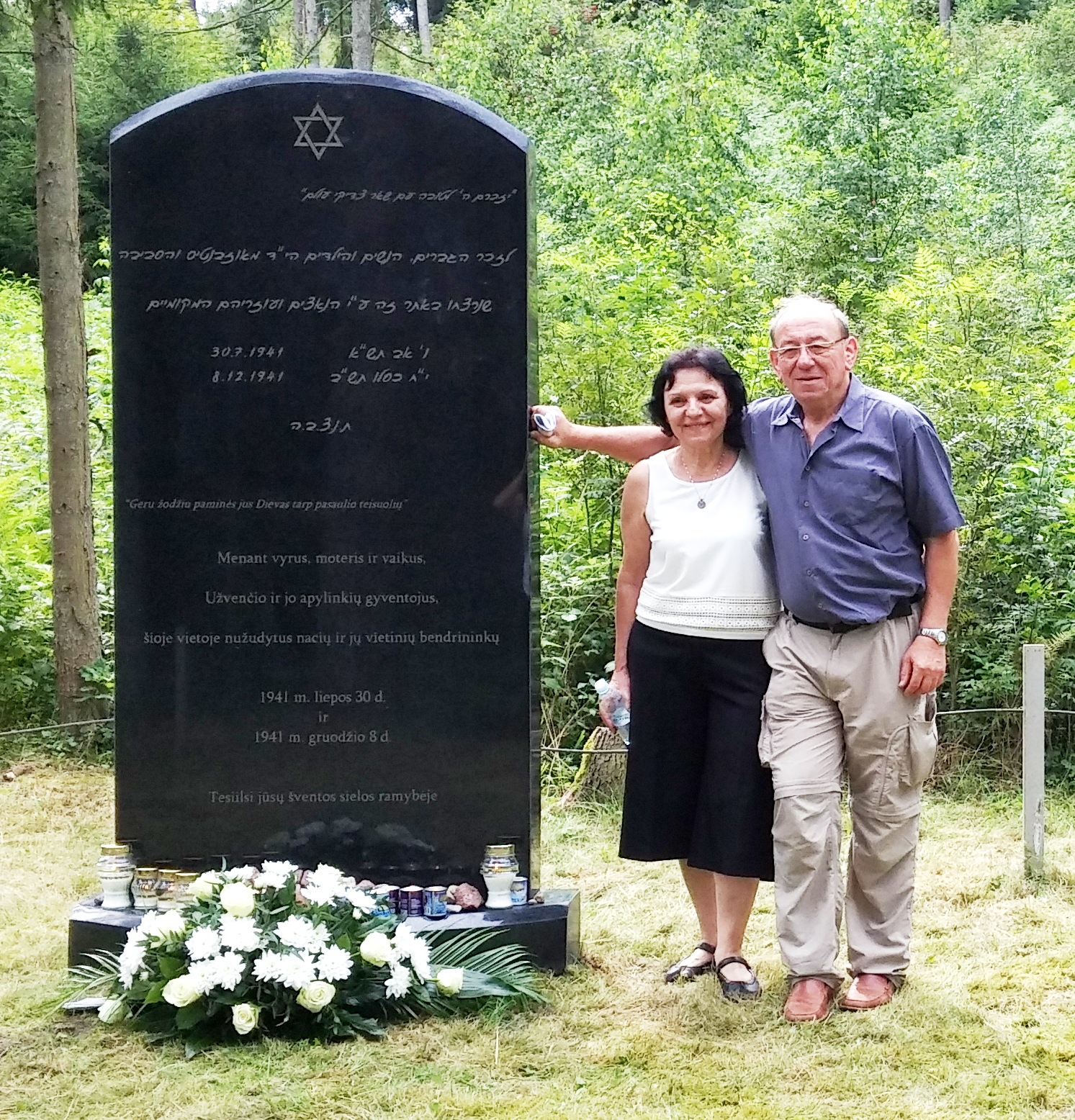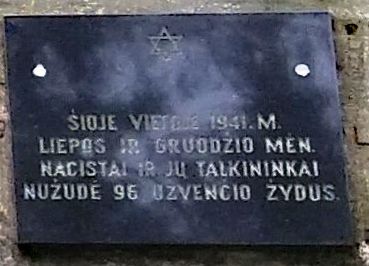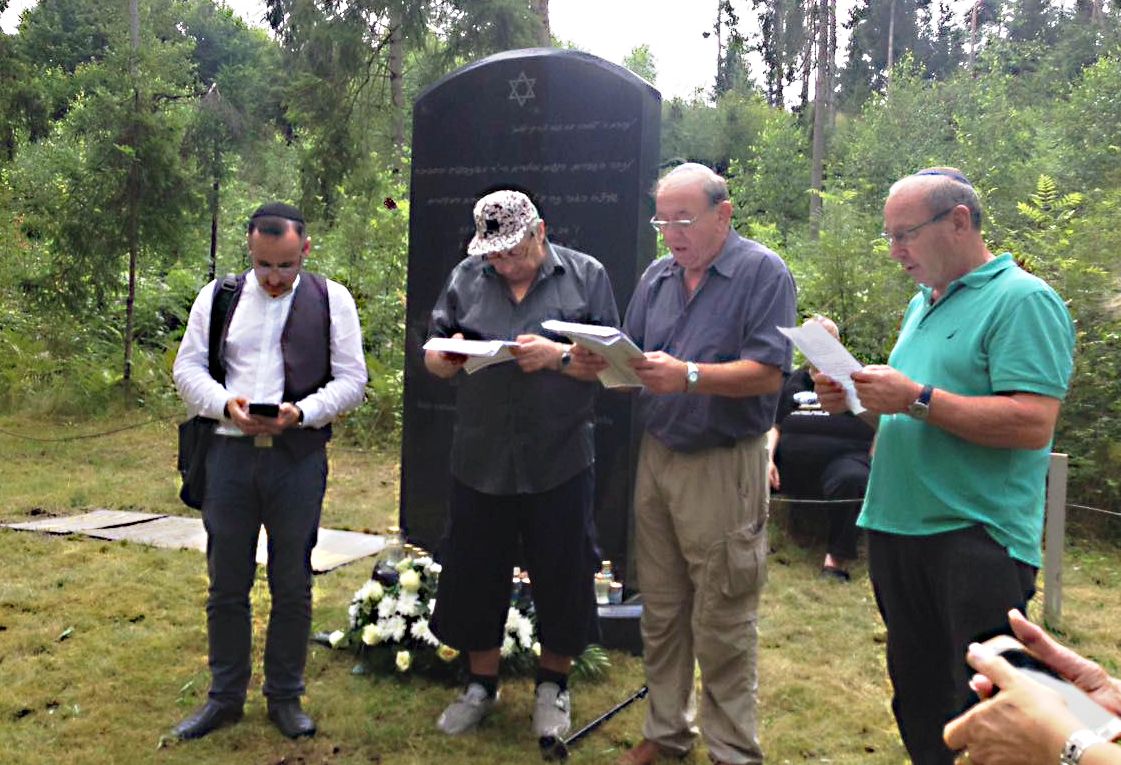Užventis World War II Execution Site
Following is Vola Levin's account of his involvement in the successful quest to restore memorialization of the site of the 1941 massacre of the Jews of Užventis...
Contributed by:
Vola Levin

Kfar-Saba, Israel
The family of my father, Leiba Levin,
comes from Užventis, a small village in the Šiauliai district of Lithuania, with
a Jewish population of about 100 men prior to WWII. The Nazis occupied
Užventis in the first days of the war, in June 1941, and immediately gathered
the entire Jewish population in a temporary concentration camp in the village.
A month later, on July 30, all old men and children – about 80 people in total - were executed by the Lithuanian collaborators and buried in a cave in Želviai (Zhelviu) forest, about two miles from Užventis. Among the murdered were my grandparents, Abram and Sheine Levin, and four of their nine children, along with my grandfather’s brother, Moishe Levin, and the rest of his family (wife and eight children). Later the same year, on December 8, 1941, all remaining Jews in Užventis - about 17 in total - were brought to the same place in Zhelviu forest, executed and buried in another cave next to the first one.
After the war, Soviet authorities recognized the execution site in Želviai forest as a memorial site and even raised a memorial stone, declaring an “execution of Soviet citizens by Nazis and their collaborators.”
Later, in the 1950s, the local population in Užventis and surrounding villages began to display an unhealthy interest in the execution site, by opening the first cave and looking for gold teeth and other valuables. In 1956, my father with Eliah Cvikas and Rachel Kazav, other descendants of Užventis Jewish families, received an approval from Vilnius Synagogue, moved all bodies from the first grave to the Jewish cemetery in Vilnius and buried them in a mass grave. A year later, in 1957, my father died from a stroke, when I was six.
In June 2009, I took my mother Feiga, 86 years old then, to visit Kraziai, her birthplace in Lithuania, a village located about 20 km from Užventis. To that trip I also invited my older cousin Benny Kelman, who was born in Užventis in 1935, so we planned to visit Užventis as well.
Prior to the trip I found and met Dr. Rose Lerer Cohen, an active member of Litvak SIG and a descendant of the Lerer family from Užventis. As a specialist in genealogy, Rose had performed a many years’ research on the history of the Užventis Jewish community; she passed to me several pictures and documents, including testimonies of Rachel Kazav and official lists of the executed names, and a lot of relevant and important information, both on the execution site and the mass grave in Vilnius. She also connected me with Leonas Cvikas, one of two sons of late Eliah Cvikas, who lives in Užventis presently.
After arrival in Užventis, we met with Leonas, who showed us the village and all the Jewish houses in the center while relating many interesting stories and information. Based on that information, I prepared a map of the village center – “then and now”. When we arrived at Želviai forest, we found the execution site in a neglected and rundown condition. The access road was hardly passable; the whole area was full of wild growth and the old Soviet memorial stone looked very bad. The same was observed at the old Jewish cemetery of Užventis – absolutely destroyed.
Later during the same trip, we visited the Jewish cemetery in Vilnius and found the mass grave in similarly dilapidated condition. Since this is my grandparents’ burial site, erected by my father more than 50 years ago, I felt personally responsible for it and, with help from friends in Vilnius, immediately contracted with local specialists for grave renovation on my personal account. The renovation of the mass grave was been completed in several months, and it now looks fairly decent.
Following our visit, together with Rose, we decided to apply to the regional government in Kelme, Lithuania, the principal city in the region, with a request to restore and preserve the memorial site in Želviai forest, and decided to raise a memorial stone on the site after restoration by us, the descendants of the executed families. First, we sent a letter with our requests to Mr. Kazlauskas, Director for preservation of memorial sites in Kelme, but received no response. Then, Rose applied for help to Lord Janner of Braunstone from U.K, a well-known activist in Jewish memorial sites preservation in the Baltic countries, but his application to Kelme was neglected as well. Only with help from Leonas, we managed to obtain the following information: due to winter weather, the authorities decided to postpone any decision until the spring. Frankly, we were somewhat desperate.
 But then, in the beginning of 2010, I told the whole story to my cousin Marc
Fernich,
But then, in the beginning of 2010, I told the whole story to my cousin Marc
Fernich,
a lawyer from New York. Per his advice, I prepared an application letter, which Marc
sent to six Jewish Congressmen and to Secretary of State, Hillary Clinton. The first to
respond was Congressman Jerrold Nadler from NY, who sent a
letter to the Lithuanian Ambassador to the U.S.A., with copies to the State Department
and to the U.S. Ambassador in Lithuania, Mrs. Anne Derse. The Lithuanian Ambassador
didn't respond but Ambassador Derse, through coordination with the Lithuanian
Foreign Ministry, immediately sent an embassy officer to Užventis to review the
execution site. Since then, the things started to move fast. Even prior to the arrival of
the reviewing officer from the U.S. embassy, the site was cleaned, the old Soviet memorial stone was cleaned as well and a marble plate was installed on it, and directional signs to the execution site were positioned on the main road.
During the following months, I had several phone talks with the Kelme mayor, Mr. Arvasiavicius, to whom I presented and discussed our requests, and we’ve closed issues. In parallel, with help of my friends from Vilnius, we found a contractor and ordered the memorial stone. All decisions, including the shape of the stone and wording on it, were made together with Rose Lerer Cohen. The funding for the stone was shared equally by eight families of descendants: Rose Lerer Cohen, her brother, Leonas Cvikas, my sister Gita Goldberg, my cousins Benny Kelman, Abram Rubinshtein and Malka Glas, and me.
At the end of July 2010, I arrived in Lithuania with my son and we had a final coordination meeting at the execution site with the Kelme mayor and the stone contractor to finalize all aspects. I agreed that the local authorities would undertake to clean the place, to cut trees inside and around
the site and to install a new fence. They also proposed to remove the old
Soviet stone, but I refused.
place, to cut trees inside and around
the site and to install a new fence. They also proposed to remove the old
Soviet stone, but I refused.
The commemoration ceremony was held at the execution site on August 30, 2010, with participation of the U.S. ambassador, the deputy Israeli ambassador in Latvia and Lithuania, representatives from the Lithuanian Foreign Ministry, the Kelme mayor, the Elder of Užventis, head of the Šiauliai Jewish community, the
Cvikas family and about 15 members of the Levin family from Israel and the U.S.A. After speeches by several participants, we held a traditional Jewish ceremony, including Kaddish and “El Male Rachamim”.
A year later, two teachers from the local high school made an outstanding move: they organized the pupils to prepare stones by painting the names of the murdered on them, arrived at the execution site, cleaned it and, according to Jewish tradition, put the small stones around the memorial stone. That same year, on the Holocaust Day, the pupils constructed a Menorah from the small stones at the base of the memorial stone. After I heard about it from Leonas, I contacted the U.S. Embassy in Vilnius, and, per my recommendation, Ambassador Derse sent appreciation letters to the teachers.
On July 29th, 2016 we held the 75 years’ yahrzeit commemoration ceremony at the execution site, with participation of Užventis elders, families of Leonas and Zame Cvikas, Rose Lerer Cohen and her son, descendants of the Olshvang family from Kaunas, and 15 members of Levin family from Israel.
A month later, on July 30, all old men and children – about 80 people in total - were executed by the Lithuanian collaborators and buried in a cave in Želviai (Zhelviu) forest, about two miles from Užventis. Among the murdered were my grandparents, Abram and Sheine Levin, and four of their nine children, along with my grandfather’s brother, Moishe Levin, and the rest of his family (wife and eight children). Later the same year, on December 8, 1941, all remaining Jews in Užventis - about 17 in total - were brought to the same place in Zhelviu forest, executed and buried in another cave next to the first one.
Silvia and Vola Levin
After the war, Soviet authorities recognized the execution site in Želviai forest as a memorial site and even raised a memorial stone, declaring an “execution of Soviet citizens by Nazis and their collaborators.”
Later, in the 1950s, the local population in Užventis and surrounding villages began to display an unhealthy interest in the execution site, by opening the first cave and looking for gold teeth and other valuables. In 1956, my father with Eliah Cvikas and Rachel Kazav, other descendants of Užventis Jewish families, received an approval from Vilnius Synagogue, moved all bodies from the first grave to the Jewish cemetery in Vilnius and buried them in a mass grave. A year later, in 1957, my father died from a stroke, when I was six.
In June 2009, I took my mother Feiga, 86 years old then, to visit Kraziai, her birthplace in Lithuania, a village located about 20 km from Užventis. To that trip I also invited my older cousin Benny Kelman, who was born in Užventis in 1935, so we planned to visit Užventis as well.
Prior to the trip I found and met Dr. Rose Lerer Cohen, an active member of Litvak SIG and a descendant of the Lerer family from Užventis. As a specialist in genealogy, Rose had performed a many years’ research on the history of the Užventis Jewish community; she passed to me several pictures and documents, including testimonies of Rachel Kazav and official lists of the executed names, and a lot of relevant and important information, both on the execution site and the mass grave in Vilnius. She also connected me with Leonas Cvikas, one of two sons of late Eliah Cvikas, who lives in Užventis presently.
After arrival in Užventis, we met with Leonas, who showed us the village and all the Jewish houses in the center while relating many interesting stories and information. Based on that information, I prepared a map of the village center – “then and now”. When we arrived at Želviai forest, we found the execution site in a neglected and rundown condition. The access road was hardly passable; the whole area was full of wild growth and the old Soviet memorial stone looked very bad. The same was observed at the old Jewish cemetery of Užventis – absolutely destroyed.
Later during the same trip, we visited the Jewish cemetery in Vilnius and found the mass grave in similarly dilapidated condition. Since this is my grandparents’ burial site, erected by my father more than 50 years ago, I felt personally responsible for it and, with help from friends in Vilnius, immediately contracted with local specialists for grave renovation on my personal account. The renovation of the mass grave was been completed in several months, and it now looks fairly decent.
Following our visit, together with Rose, we decided to apply to the regional government in Kelme, Lithuania, the principal city in the region, with a request to restore and preserve the memorial site in Želviai forest, and decided to raise a memorial stone on the site after restoration by us, the descendants of the executed families. First, we sent a letter with our requests to Mr. Kazlauskas, Director for preservation of memorial sites in Kelme, but received no response. Then, Rose applied for help to Lord Janner of Braunstone from U.K, a well-known activist in Jewish memorial sites preservation in the Baltic countries, but his application to Kelme was neglected as well. Only with help from Leonas, we managed to obtain the following information: due to winter weather, the authorities decided to postpone any decision until the spring. Frankly, we were somewhat desperate.
 But then, in the beginning of 2010, I told the whole story to my cousin Marc
Fernich,
But then, in the beginning of 2010, I told the whole story to my cousin Marc
Fernich, a lawyer from New York. Per his advice, I prepared an application letter, which Marc
sent to six Jewish Congressmen and to Secretary of State, Hillary Clinton. The first to
respond was Congressman Jerrold Nadler from NY, who sent a
letter to the Lithuanian Ambassador to the U.S.A., with copies to the State Department
and to the U.S. Ambassador in Lithuania, Mrs. Anne Derse. The Lithuanian Ambassador
didn't respond but Ambassador Derse, through coordination with the Lithuanian
Foreign Ministry, immediately sent an embassy officer to Užventis to review the
execution site. Since then, the things started to move fast. Even prior to the arrival of
the reviewing officer from the U.S. embassy, the site was cleaned, the old Soviet memorial stone was cleaned as well and a marble plate was installed on it, and directional signs to the execution site were positioned on the main road.
During the following months, I had several phone talks with the Kelme mayor, Mr. Arvasiavicius, to whom I presented and discussed our requests, and we’ve closed issues. In parallel, with help of my friends from Vilnius, we found a contractor and ordered the memorial stone. All decisions, including the shape of the stone and wording on it, were made together with Rose Lerer Cohen. The funding for the stone was shared equally by eight families of descendants: Rose Lerer Cohen, her brother, Leonas Cvikas, my sister Gita Goldberg, my cousins Benny Kelman, Abram Rubinshtein and Malka Glas, and me.
At the end of July 2010, I arrived in Lithuania with my son and we had a final coordination meeting at the execution site with the Kelme mayor and the stone contractor to finalize all aspects. I agreed that the local authorities would undertake to clean the
 place, to cut trees inside and around
the site and to install a new fence. They also proposed to remove the old
Soviet stone, but I refused.
place, to cut trees inside and around
the site and to install a new fence. They also proposed to remove the old
Soviet stone, but I refused.The commemoration ceremony was held at the execution site on August 30, 2010, with participation of the U.S. ambassador, the deputy Israeli ambassador in Latvia and Lithuania, representatives from the Lithuanian Foreign Ministry, the Kelme mayor, the Elder of Užventis, head of the Šiauliai Jewish community, the
Cvikas family and about 15 members of the Levin family from Israel and the U.S.A. After speeches by several participants, we held a traditional Jewish ceremony, including Kaddish and “El Male Rachamim”.
Kaddish at the Memorial
A year later, two teachers from the local high school made an outstanding move: they organized the pupils to prepare stones by painting the names of the murdered on them, arrived at the execution site, cleaned it and, according to Jewish tradition, put the small stones around the memorial stone. That same year, on the Holocaust Day, the pupils constructed a Menorah from the small stones at the base of the memorial stone. After I heard about it from Leonas, I contacted the U.S. Embassy in Vilnius, and, per my recommendation, Ambassador Derse sent appreciation letters to the teachers.
On July 29th, 2016 we held the 75 years’ yahrzeit commemoration ceremony at the execution site, with participation of Užventis elders, families of Leonas and Zame Cvikas, Rose Lerer Cohen and her son, descendants of the Olshvang family from Kaunas, and 15 members of Levin family from Israel.

Igal and Vola Levin - descendants of the Levin family from Užventis
Back to Užventis
Home Page
© 2013 R. Barry Spinak
Created: Nov
2013 Updated: Nov. 2016
Get
involved!
This page is hosted at no cost to the public by JewishGen, Inc., a non-profit corporation.
If you feel there is a benefit to you in accessing this site, please consider participating through
Jewish-Gen-erosity.
This page is hosted at no cost to the public by JewishGen, Inc., a non-profit corporation.
If you feel there is a benefit to you in accessing this site, please consider participating through
Jewish-Gen-erosity.
